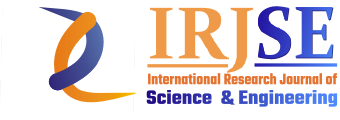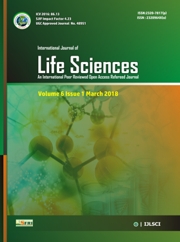RESEARCH ARTICLES
Volume 8 |Issue 1| January-February 2020 First published: 30 February 2020
Review of Aurora borealis spectacular manifestations of solar wind and atmosphere.
Dr (Ms) Swaroopa Rani N. Gupta
Department of Chemistry, Brijlal Biyani Science College Amravati, Maharashtra, India
Abstract
Keywords: Aurora, Auroral particles, Earth, Solar wind, Atmosphere, Ionosphere, Magnetosphere, Aurora Borealis.
Editor: Dr.Arvind Chavhan
Cite this article as:
Gupta Swaroopa Rani N. Review of Aurora borealis spectacular manifestations of solar wind and atmosphere, Int. Res. Journal of Science & Engineering, 2020 Volume 8 Issue 1 : 5-23
References
1. Yahnin, AG, Sergeev VA, Gvozdevsky BB, Vennerstrøm S (1997). "Magnetospheric source region of discrete auroras inferred from their relationship with isotropy boundaries of energetic particles". Annales Geophysicae. 15 (8): 943. Bibcode: 1997AnGeo..15..943Y. doi:10.1007/s00585-997-0943z.
2. Zhu L, Schunk RW, Sojka JJ. (1997). "Polar cap arcs: A review". Journal of Atmospheric and SolarTerrestrial Physics. 59 (10): 1087. Bibcode :1997J ASTP..59.1087Z. doi:10.1016/S1364-6826(96)00113-7.
3. A, Brekke; A, Egeland (1994). The Northern Lights. Grøndahl and Dreyer, Oslo. p. 137. ISBN 82-5042105-1.
4. Windows to the Universe – Auroral colors and spectra".
5. "NASA's MAVEN Orbiter Detects Ultraviolet Aurora on Mars | Space Exploration | SciNews.com". sci-news.com. Retrieved 16 August 2015.
6. Aurora Borealis". dapep.org. Retrieved 16 August 2015.
7. Gurnett, D.A. (1974). "The Earth as a radio source". Journal of Geophysical Research. 79 (79): 4227. Bibcode:1974JGR....79.4227G. doi:10.1029/JA07 9i028p04227.
8. Anderson, K.A. (1960). "Balloon observations of Xrays in the auroral zone". Journal of Geophysical Research. 65: 551– 564. Bibcode:1960JGR....65..551A. doi:10.1029/jz065i 002p00551.
9. Auroras Make Weird Noises, and Now We Know Why". 2016-06-27. Retrieved 2016-06-28.
10. News: Acoustics researcher finds explanation for auroral sounds". 2016-06-21. Retrieved 2016-06-28.
11. Burch, J L (1987). Akasofu S-I and Y Kamide, ed. The solar wind and the Earth. D. Reidel. p. 103. ISBN 90-277-2471-7.
12. McIlwain, C E (1960). "Direct Measurement of Particles Producing Visible Auroras". Journal of Geophysical Research. 65: 2727. Bibcode:1960JGR....65.2727M. doi:10.1029/JZ0 65i009p02727.
13. Reiff, P. H.; Collin, H. L.; Craven, J. D.; Burch, J. L.; Winningham, J. D.; Shelley, E. G.; Frank, L. A.; Friedman, M. A. (1988). "Determination of auroral electrostatic potentials using high- and low-altitude particle distributions". Journal of Geophysical Research. 93: 7441. Bibcode:1988JGR....93.7441R. doi:10.1029/JA09 3iA07p07441.
14. Bryant, D. A.; Collin, H. L.; Courtier, G. M.; Johnstone, A. D. (1967). "Evidence for Velocity Dispersion in Auroral Electrons". Nature. 215 (5096): 45. Bibcode:1967Natur.215...45B. doi:10.1038/215045 a0.
15. Ultraviolet Waves". Archived from the original on 27 January 2011.
16. Schield, M. A.; Freeman, J. W.; Dessler, A. J. (1969). "A Source for Field-Aligned Currents at Auroral Latitudes". Journal of Geophysical Research. 74: 247– 256. Bibcode:1969JGR....74..247S. doi:10.1029/JA074i 001p00247.
17. Armstrong, J. C.; Zmuda, A. J. (1973). "Triaxial magnetic measurements of field-aligned currents at 800 kilometers in the auroral region: Initial results". Journal of Geophysical Research. 78 (28): 6802– 6807. Bibcode:1973JGR....78.6802A. doi:10.1029/JA0 78i028p06802.
18. Birkeland, Kristian (1908). The Norwegian Aurora Polaris Expedition 1902–1903. New York: Christiania (Oslo): H. Aschehoug & Co. p. 720. outof-print, full text online
19. Crooker, N. U.; Feynman, J.; Gosling, J. T. (1 May 1977). "On the high correlation between long-term averages of solar wind speed and geomagnetic activity". NASA.
20. Alaska.edu Archived 20 December 2006 at the Wayback Machine., Solar wind forecast from a University of Alaska website
21. https://en.wikipedia.org/wiki/Magnetosphere_pa rticle_motion#/media/File:Structure_of_the_magne tosphere-en.svg
22. Shue, J.-H; Chao, J. K.; Fu, H. C.; Russell, C. T.; Song, P.; Khurana, K. K.; Singer, H. J. (May 1997). "A new functional form to study the solar wind control of the magnetopause size and shape". J. Geophys. Res. 102 (A5): 9497– 9511. Bibcode:1997JGR...102.9497S. doi:10.1029/97J A00196.
23. Lyons, L. R.; Kim, H.-J.; Xing, X.; Zou, S.; Lee, D.-Y.; Heinselman, C.; Nicolls, M. J.; Angelopoulos, V.; Larson, D.; McFadden, J.; Runov, A.; Fornacon, K.H. (2009). "Evidence that solar wind fluctuations substantially affect global convection and substorm occurrence". J. Geophys. Res. 114 (A11306): 1– 14. Bibcode:2009JGRA..11411306L. doi:10.1029/2009 JA014281.
24. NASA – THEMIS Satellites Discover What Triggers Eruptions of the Northern Lights". Nasa.gov. Archived from the original on 29 June 2011. Retrieved 26 July 2011.
25. Angelopoulos, V.; McFadden, J. P.; Larson, D.; Carlson, C. W.; Mende, S. B.; Frey, H.; Phan, T.; Sibeck, D. G.; Glassmeier, K.-H.; Auster, U.; Donovan, E.; Mann, I. R.; Rae, I. J.; Russell, C. T.; Runov, A.; Zhou, X.-Z.; Kepko, L. (2008). "Tail Reconnection Triggering Substorm Onset". Science. 321 (5891): 931–5. Bibcode:2008Sci...321..931A. doi:10.1126/science.1 160495. PMID 18653845.
26. Bryant, Duncan (1998). Electron-Acceleration-in-theAurora-and-Beyond. Bristol & Philadelphia: Institute of Physics Publishing Ltd. p. 163. ISBN 0750305339.
27. Evans, D S (1975). Hot Plasma in the Magnetosphere. New York and London: Plenum Press. pp. 319–340. ISBN 0306337002.
28. Boström, Rolf "Observations of weak double layers on auroral field lines" (1992) IEEE Transactions on Plasma Science (ISSN 0093-3813), vol. 20, no. 6, pp. 756–763
29. Ergun, R. E., et al. "Parallel electric fields in the upward current region of the aurora: Indirect and direct observations" (2002) Physics of Plasmas, Volume 9, Issue 9, pp. 3685–3694
30. Carlson, C.W., R.F.Pfaff and J.G.Watzin (June 1998). "The Fast Auroral SnapshoT (FAST) mission". Geophysical Research Letters. 25 (12): 2013– 2016. Bibcode:1998GeoRL..25.2013C. doi:10.1029/98 GL01592.
31. Lev Davidovich Landau". history.mcs.standrews.ac.uk.
32. Cairns, R A (1993). Dendy, R O, ed. Plasma Physics:An Introductory Course. Cambridge University Press. pp. 391–410. ISBN 0521433096.
33. Bryant, D A; Perry, C H (1995). "Velocity-space distributions of wave-accelerated auroral electrons". Journal of Geophysical Research. 100 (A12): 23,711– 23,725. Bibcode:1995JGR...10023711B. doi:10.1029/95 ja00991.
34. https://www.britannica.com/science/ionosphereand-magnetosphere 35. https://en.wikipedia.org/wiki/File:Aurora_%26_ moon.jpg)
36. https://en.wikipedia.org/wiki/Aurora#/media/Fi le:Virmalised_17.03.15.jpg
37. https://en.wikipedia.org/wiki/Aurora#/media/Fi le:Virmalised_18.03.15.jpg
38. https://en.wikipedia.org/wiki/Aurora#/media/Fi le:Virmalised_18.03.15_(2).jpg
39. https://en.wikipedia.org/wiki/Aurora#/media/Fi le:Virmalised_18.03.15_(3).jpg
40. https://en.wikipedia.org/wiki/Aurora#/media/Fi le:Virmalised_18.03.15_(4).jpg)
41. https://en.wikipedia.org/wiki/Aurora#/media/Fi le:Virmalised_07.10.15.jpg
42. https://en.wikipedia.org/wiki/Aurora#/media/Fi le:Virmalised_07.10.15_(2).jpg
43. https://en.wikipedia.org/wiki/Aurora#/media/Fi le:Virmalised_14.12.15.jpg
44. https://en.wikipedia.org/wiki/Aurora#/media/Fi le:L%27Eyjafjallaj%C3%B6kull_sous_les_aurores_bo r%C3%A9ales.jpg
45. https://upload.wikimedia.org/wikipedia/common s/c/cf/Northern_Lights_02.jpg
46. https://en.wikipedia.org/wiki/File:Polarlicht_2.jpg
47. https://en.wikipedia.org/wiki/File:Red_and_gree n_aurora.jpg)
48. https://en.wikipedia.org/wiki/Aurora#/media/Fi le:Moon_and_Aurora.jpg
49. https://en.wikipedia.org/wiki/Aurora#/media/Fi le:Aurora_Borealis.jpg

